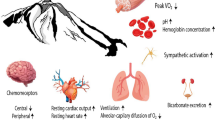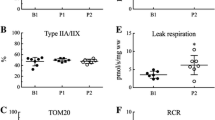Summary
The influence of short-term high-altitude (HA) residence on intramuscular pH and skeletal muscle enzyme activity of sea-level (SL) residents was investigated. Vastus lateralis muscle samples were obtained by biopsy from rested subjects (n=5) at SL (50 m) and on the 18th day of HA residence (4,300 m) for determination of glycogen phosphorylase, hexokinase, malate dehydrogenase, and total lactate dehydrogenase activities. A second group of subjects (n=6) performed cycle exercise of the same absolute intensity (mean ± SE=195±5 W) at SL and on the 15th day of residence at HA. Before and immediately after exercise, vastus lateralis muscle samples were obtained for the determination of intramuscular pH, and venous blood was obtained for determination of lactate concentration. The first group of subjects showed no significant changes in skeletal muscle enzyme activity after 18 days at HA. The second group of subjects were instructed to exercise for exactly 30 min, and all but one could complete the entire bout at SL. However, at HA, none could continue 30 min, and time to exhaustion (mean ± SE) was 11.9±1.6 min. Resting intramuscular pH was not significantly different after HA residence as compared to SL. The fall in intramuscular pH was less with exercise on day 15 at HA than during SL exercise. Likewise, the increase in blood lactate concentration with exercise at HA was less than at SL. These data indicate that, after 15–18 days of HA residence, limitations in exercise performance are not due to inordinate intramuscular acidosis or to changes in the activity of glycolytic and oxidative enzymes.
Similar content being viewed by others
References
Baldwin KM, Winder WW, Terjung RL, Holloszy JO (1973) Glycolytic enzymes in different types of skeletal muscle: Adaptation to exercise. Am J Physiol 225: 962–966
Bergmeyer HN (1974) Methods of enzymatic analysis, vol. I. Academic Press, New York
Bergstrom J (1962) Muscle electrolytes in man. Scand J Clin Lab Invest [Suppl] 68: 1–110
Costill DL, Daniels J, Evans W, Fink W, Krahenbuhl G, Saltin B (1976) Skeletal muscle enzymes and fiber composition in male and female track athletes. J Appl Physiol 40: 149–154
Costill DL, Coyle EF, Fink WF, Lesmes GR, Witzmann FA (1979) Adaptations in skeletal muscle following strength training. J Appl Physiol: Respirat Environ Exercise Physiol 46: 96–99
Costill DL, Sharp RL, Fink WJ, Katz A (1982) Determination of human muscle pH in needle-biopsy specimens. J Appl Physiol: Respirat Environ Exercise Physiol 53: 1310–1313
Evans WJ, Bennett AS, Costill DL, Fink WJ (1979) Leg muscle metabolism in trained and untrained men. Res Q Am Assoc Health Phys Educ 50: 350–359
Gevers W, Dowdle E (1963) The effect of pH on glycolysis in vitro. Clin Sci Mol Med 25: 343–349
Gleser MA, Vogel JA (1973) Endurance capacity for prolonged exercise on the bicycle ergometer. J Appl Physiol 34: 438–442
Holloszy JO, Booth FW (1976) Biochemical adaptations to endurance exercise in muscle. Annu Rev Physiol 38: 273–291
Horstman D, Weiskopf R, Jackson RE (1980) Work capacity during a 3-week sojourn at 4,300m: effects of relative polycythemia. J Appl Physiol: Respirat Environ Exercise Physiol 49: 311–318
Hultman E (1967) Physiological role of muscle glycogen in man, with special reference to exercise. Circ Res [Suppl 1] 20–21: 99–114
Lehninger AL (1970) Biochemistry. Worth Publishers, New York, p 409
Maher JT, Jones LG, Hartley LH (1974) Effects of high-altitude exposure on submaximal endurance capacity of men. J Appl Physiol 37: 895–898
Mansour TE, Wakid N, Sprouse HM (1966) Studies on heart phosphofructokinase. J Biol Chem 242: 1512–1521
Reynafarje B (1962) Myoglobin content and enzymatic activity of muscle and altitude adaptation. J Appl Physiol 17: 301–305
Sue DU, Hansen JE, Blais M, Wasserman K (1980) Measurement and analysis of gas exchange during exercise using a programmable calculator. J Appl Physiol: Respirat Environ Exercise Physiol 49: 456–461
Sutton JR, Jones NL, Tews CJ (1981) Effect of pH on muscle glycolysis during exercise. Clin Sci Mol Med 61: 331–338
Trivedi B, Danforth WH (1966) Effect of pH on the kinetics of frog muscle phosphofructokinase. J Biol Chem 241: 4110–4112
Young AJ, Evans WJ, Cymerman A, Pandolf KB, Knapik JJ, Maher JT (1982) Sparing effect of chronic high-altitude exposure on muscle glycogen utilization. J Appl Physiol: Respirat Environ Exercise Physiol 52: 857–862
Author information
Authors and Affiliations
Rights and permissions
About this article
Cite this article
Young, A.J., Evans, W.J., Fisher, E.C. et al. Skeletal muscle metabolism of sea-level natives following short-term high-altitude residence. Europ. J. Appl. Physiol. 52, 463–466 (1984). https://doi.org/10.1007/BF00943381
Accepted:
Issue Date:
DOI: https://doi.org/10.1007/BF00943381




